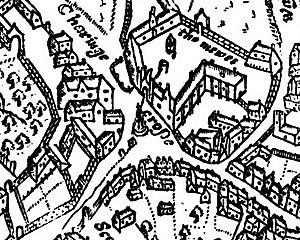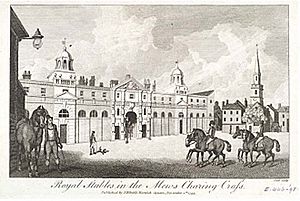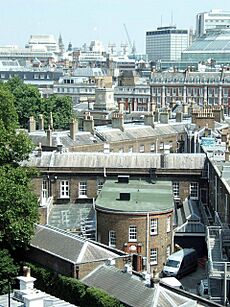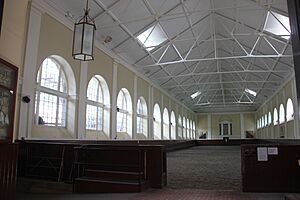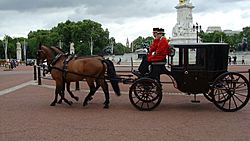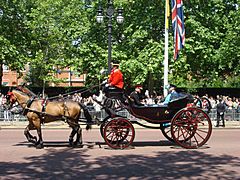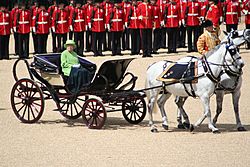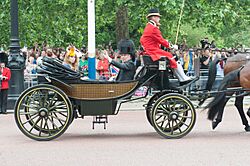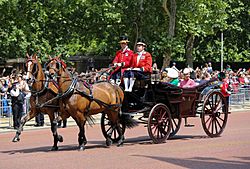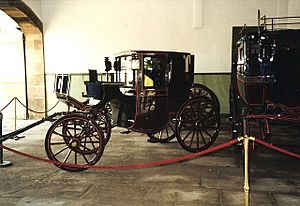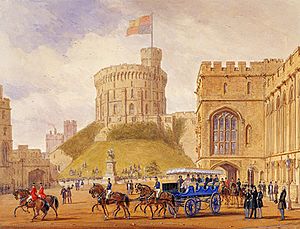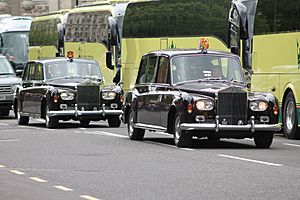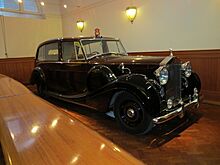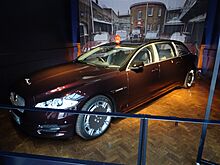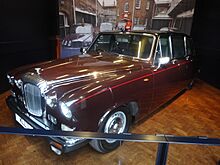Royal Mews facts for kids
The Royal Mews is like a special home for the British Royal Family's horses, carriages, and cars. It's where these important vehicles are kept, looked after, and prepared for royal events.
This famous place has been in two main locations in London. First, it was near Charing Cross, and since the 1820s, it has been located within the grounds of Buckingham Palace.
The Royal Mews at Buckingham Palace is open to visitors for much of the year. You can see many royal carriages and other interesting items there. But it's also a busy, working part of the palace. Horses and people live and work there every day, and carriages and cars are constantly used to support the King in his role as the country's leader.
The person in charge of the Royal Mews is called the Master of the Horse. The person who actually runs the daily operations is the Crown Equerry, who lives at the Mews and manages the Royal Mews Department.
Contents
History of the Royal Mews
The First Royal Mews at Charing Cross
The very first stables known as a "mews" were located at Charing Cross in London. From 1377, royal hawks (birds of prey) were kept there. The name "mews" comes from the French word "muer," which means "to moult." This is because the hawks were kept there when they were shedding their old feathers.
Later, in 1534, the royal stables in another area were destroyed by fire. So, King Henry VIII decided to turn the Charing Cross mews into stables for horses. Even though it was now for horses, it kept its original name. On old maps, you can see the Mews stretching towards where Leicester Square is today.
When King George I became king in 1714, he brought his famous cream-colored horses from Hanover (a part of Germany). These beautiful horses, bred at the Royal Stud at Hampton Court, pulled state carriages in England for the next 200 years.
The Mews was rebuilt again in 1732 by William Kent. In the early 1800s, this building was often called the King's Mews (or Queen's Mews if a queen was on the throne). It was even open to the public.
Kent's new building was a grand, classical design. It had a large open space in front, which was rare in central London at the time.
In 1820, the entire site was cleared to make way for Trafalgar Square, which was built between 1837 and 1844, and the National Gallery, which opened in 1838.
The Royal Mews at Buckingham Palace
The Royal Mews we see today is located within the grounds of Buckingham Palace, south of the palace gardens.
In the 1760s, King George III moved some of his everyday horses and carriages to Buckingham House, which he had bought for his wife. The Riding School, designed by William Chambers, was finished in 1764. The main royal stables with the grand ceremonial coaches stayed at Charing Cross. However, when King George IV decided to turn Buckingham Palace into the main royal home in the 1820s, the entire stable operation moved there.
The current Royal Mews was designed by John Nash and finished in 1825. It has been changed quite a bit since then. The main area has coach houses on one side and stables on the other.
When Queen Victoria became queen in 1837, Buckingham Palace became the main home for the monarch. Prince Albert used the back stables for his own horses. By the 1850s, almost 200 people worked at the Mews, and most of them lived there with their families. There were official homes for important staff, and other workers lived in rooms above the stables. In 1855, Queen Victoria even started a school at the Royal Mews for the children of the workers.
Under Queen Victoria's son, King Edward VII, motor vehicles were brought into the Mews. In 1904, a request was made to turn two small coach houses into a "Motor House" with heating and electric lights. This was done, and homes for chauffeurs were also provided nearby.
In the early 1900s, there were some issues with the Hanoverian cream horses. So, in 1920, they were no longer used, and bay (brown) horses took their place. However, in the early 1930s, King George V started using grey horses for state processions. His son, Edward VIII, moved these grey horses from Windsor to London, where they became known as the 'Windsor Greys'.
By 1936, motor vehicles were becoming more common. King Edward VIII sold off many of the everyday carriages. After World War II, George VI sold even more. For example, 16 plain Edwardian town coaches were sold. A total of 19 carriages were bought by a film producer, Alexander Korda, to use as movie props. Five of these were even borrowed back in 1953 for Queen Elizabeth II's coronation! That coronation involved 34 coaches and carriages with 78 horses.
In 1988, a new state coach was given to the Mews, called the Australian State Coach. It was built as part of Australia's 200th birthday celebrations. At that time, the Royal Mews still had over 100 vehicles, with most of them in working order.
The Royal Mews Today
Today, the Royal Mews at Buckingham Palace is a busy working place and is also open to the public. The grand state coaches and other carriages are kept there, along with about 30 horses. Modern royal cars are also housed there. Coachmen, grooms, chauffeurs, and other staff live in apartments above the carriage houses and stables.
Carriage Horses
The Royal Mews has about a dozen Windsor Greys and 18 Cleveland Bay horses. These horses regularly practice pulling carriages. This is why horse-drawn transport is still used for daily messenger trips between Buckingham Palace and St James's Palace. The horses are also used for fun driving competitions and for royal duties. The horse manure is even used in the nearby Buckingham Palace Garden!
Royal and State Carriages
Here are some of the carriages kept at the Mews. Many are on public display, though not all are in London. Most are used regularly, like the broughams, which are driven daily. Others, like the Gold Coach, are only used for very special and rare state events.
-
A clarence from the Royal Mews, pulled by two Cleveland Bay horses, passing the Victoria Memorial.
-
One of two Royal Mews barouches carrying members of the Royal Family at the 2009 Trooping the Colour.
-
Queen Elizabeth II riding in a phaeton, pulled by Windsor Grey horses, at the 2007 Trooping the Colour. This carriage is called the "Ivory-mounted Phaeton."
Here is a list of some of the vehicles cared for by the Royal Mews:
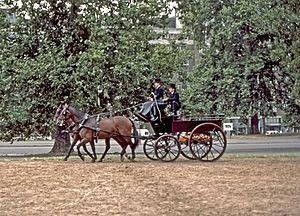
- The Gold State Coach
- The Irish State Coach
- The Scottish State Coach
- The Australian State Coach
- The Diamond Jubilee State Coach
- Queen Alexandra's State Coach
- The Glass Coach
- King Edward VII's Town Coach
- Several landau carriages, including:
- The 1902 State Landau
- Seven other state landaus
- Five semi-state landaus
- Five Ascot landaus
- Barouches and sociables
- Broughams and clarences
- Phaetons and victorias
- Sporting carriages, like a rare curricle
- Fun vehicles, such as the Louis-Philippe charabanc
- Many pony carriages, drags, and exercise vehicles
Also on display are beautiful historic uniforms and harnesses, which are also used regularly. These range from simple items for exercising horses to fancy state uniforms and harnesses for the grand state coaches.
Royal Motor Vehicles
Looking after and providing modern cars is just as important at the Royal Mews as caring for carriages and horses. King Edward VII set up the first garage there in the early 1900s.
The main official cars are all painted in a special black and deep red color, known as Royal Claret. They are driven and maintained by chauffeurs who work at the Mews. The head chauffeur is mainly responsible for driving the King.
State Cars
The five main state cars do not have regular number plates. They include:
- Two identical Bentley State Limousines (one was given to Queen Elizabeth II in 2002 for her 50th year as Queen, and the other was bought at the same time).
- Two Rolls-Royce Phantom VI limousines: one from 1978 and one from 1986. They look very similar, but the 1978 one has a slightly higher roof.
- A rare 1950 Rolls-Royce Phantom IV limousine, which was the first of its kind.
Other Official Vehicles
The following vehicles are used for less formal events and as support cars. They are also painted in the royal claret and black colors:
- Three Daimler DS420 limousines, from 1988 and 1992.
- Two 2012 Jaguar XJ limousines.
- Three 2022 Range Rovers.
- The State Hearse used for Queen Elizabeth II's funeral.
Land Rovers, luggage cars, and people carriers are also kept at the Royal Mews. Since 2012, several electric vehicles have been added, including a BMW i3, a BMW 7 Series hybrid, a Nissan van, and a Renault Twizy.
- Cars on display at the Royal Mews
The Royal Mews Department Staff
The Royal Mews Department has many staff members who work to keep everything running smoothly. Around 50 people lived and worked at the Mews at the end of the 1900s. The person in charge of the staff used to be called the Superintendent, but that role was changed in 2000.
| Crown Equerry | |||||||||||||||||||||||||||||||||||||||||||||||
| Superintendent of the Royal Mews |
|||||||||||||||||||||||||||||||||||||||||||||||
| Veterinary Surgeon |
Horsebox Driver of Windsor |
Stud Groom of Hampton Court |
Stud Groom of Windsor |
Comptroller of Stores |
Chief Clerk | ||||||||||||||||||||||||||||||||||||||||||
| Storeman | Carriage Restorers |
Daily Ladies of London |
Daily Ladies of Windsor |
Deputy Chief Clerk |
|||||||||||||||||||||||||||||||||||||||||||
| Head Chauffeur | Head Coachman | Assistant Chief Clerk |
|||||||||||||||||||||||||||||||||||||||||||||
| Deputy Head Chauffeur |
Deputy Head Coachman |
||||||||||||||||||||||||||||||||||||||||||||||
| First Chauffeurs | Sergeant Farrier | Rough Rider | Senior Liveried Helpers |
Carriage Cleaners | Yardmen | ||||||||||||||||||||||||||||||||||||||||||
| Second Chauffeurs | Liveried Helpers | ||||||||||||||||||||||||||||||||||||||||||||||
Other Royal Mews Locations
There are other Royal Mews locations besides Buckingham Palace:
- The Royal Mews at Hampton Court Palace provides homes for royal staff, and horses are sometimes stabled there. It is not open to the public.
- There is a working Royal Mews at Windsor Castle where the Ascot carriages are usually kept, along with vehicles used in Windsor Great Park. Some horses for riding are also stabled here.
- At Holyrood Palace in Edinburgh, the Royal Mews is one of the oldest parts of the Palace. It is still used whenever royal carriages are needed in Edinburgh.
Historically, the old stables of St James's Palace were also sometimes called the Royal Mews.
See also
 In Spanish: Royal Mews para niños
In Spanish: Royal Mews para niños
- Japan state carriages
- Royal Stables (Denmark)
- Royal Stables (Sweden)


